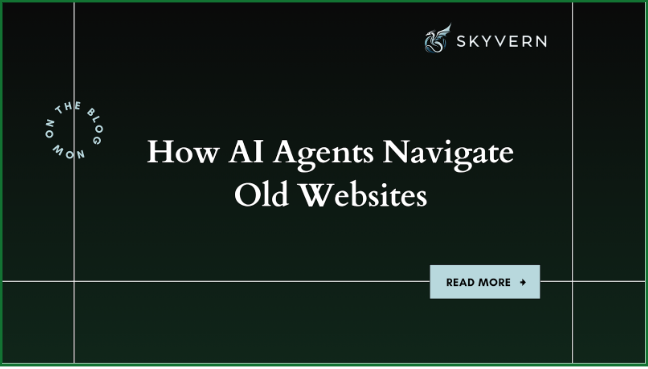How AI Agents Navigate Old Websites

You've probably dealt with those outdated websites or really clunky online portals and
you know how frustrating they can be. Maybe you’ve had to log into a government site with a somewhat ancient interface, submit a job application through a very slow, multi-step process, or extract data from a vendor portal that feels like it hasn’t been updated in decades.
For anybody or business that typically relies on these platforms for important work, like retrieving invoices; using regular automation can really cause you to struggle. I think it's pretty obvious that old websites weren’t exactly built with automation in mind, and they come with a lot of challenges that make things even harder.
This is why using “AI agents’’ is really the way to go.
AI agents, unlike automation tools that have to rely on rigid scripts; can think, adapt, and navigate old websites just like a human.
Let's break down how AI agents actually handle these outdated platforms, why this is really important, and how you can use this technology to simplify your work.
Why Are Old Websites Hard to Automate?
Outdated websites and legacy portals weren’t designed for automation. Many (probably all) of them were built long before AI tools ever existed, and their interfaces usually reflect that.
Here are some of the reasons why these platforms are so difficult to work with:
1. Unstructured Layouts
Older websites don’t always follow modern design standards. Buttons may be hidden, forms might be scattered across multiple pages, menus could even be buried in some very confusing layouts. Most automation tools usually depend on fixed paths or HTML structures, but if a website isn’t organized in a predictable way, these tools most likely fail.
2. Multi-Step Processes
Many outdated portals require users to click through multiple pages, enter information manually, and verify actions at several points. Government forms, procurement systems, and old job application sites mostly have complex workflows that aren’t really easy to automate with simple scripts.
3. CAPTCHA and Security Measures
Security features like CAPTCHAs (those “I’m not a robot” tests) and two-factor authentication (2FA) were designed to block bots. While they help prevent fraud, they also make it harder to automate tasks.
4. Inconsistent Data Formats
Many legacy systems don’t have standardized ways of displaying data. One day, an invoice may appear in a table format; the next, it’s in a downloadable PDF. This lack of consistency makes it hard for many automation tools to pull data reliably.
5. Website Changes and Updates
Even if a website is outdated, small changes can still happen. A button may move, a form may get a slight redesign, or a new security measure may be added. Automation scripts that depend on fixed locations or rules usually break when these changes occur, requiring constant maintenance.
How AI Agents Solve These Challenges
Unlike “conventional” automation tools, AI-powered agents are built to adapt. Instead of just following fixed rules, they can “see” and “understand” web pages like a human would. Here’s how AI agents overcome the challenges:
1. Computer Vision
Since traditional automation relies on some pretty rigid rules, such as clicking a button located at a specific spot on the page; if that button moves, the automation breaks. AI agents use computer vision, which allows them to recognize buttons, text fields, and links based on their appearance rather than their location in the code. This means AI can still function even when websites change slightly.
2. Natural Language Understanding
Most automation tools require you to write detailed scripts that specify every step. AI agents, on the other hand, can follow natural language instructions like:
- “Log into the vendor portal, go to the invoices section, and download all invoices from last month.”
- “Find job applications on this company’s career page and apply using my resume.”
- “Extract flight prices from this airline’s booking page and save them to a spreadsheet.”
Because AI can understand and process these requests in plain language, setting up automation is much easier and doesn’t require technical expertise.
3. Self-Correction
When an automation script encounters an issue, like a missing button or a slow-loading page; it usually crashes. AI agents, however, can self-correct by recognizing when something doesn’t go as planned and adjusting their approach. If an expected button isn’t visible, an AI agent can try refreshing the page, scrolling down, or finding an alternative way to complete the task.
4. Handling Security Measures
AI agents can navigate login pages that require passwords, security questions, and two-factor authentication. Some advanced AI agents can even solve CAPTCHAs, allowing them to automate workflows that traditional bots would get blocked from.
5. Extracting Data from Any Format
AI agents can pull data from websites regardless of format. Whether it’s a table, a PDF, or a set of images, AI can recognize the relevant information and extract it into a structured file like a CSV or JSON. This is really useful for businesses that need to gather reports, invoices, or customer data from various online platforms.
How You Can Use AI Automation Today
If you or your business frequently interact with outdated websites, AI automation can save you countless hours. Here’s how to get started:
1. Identify Your Repetitive Tasks – Make a list of web-based tasks you do repeatedly, such as downloading invoices, filling out forms, or applying for jobs.
2. Choose an AI Agent – You can use Skyvern which offers AI-powered web automation that doesn’t require coding.
3. Set Up Your Workflow – Use plain language instructions to tell the AI what tasks to complete.
4. Test and Optimize – Run your automation and make small adjustments to improve efficiency.
With AI agents, businesses no longer have to waste time dealing with outdated systems. Instead, they can automate complex workflows and focus on higher-value tasks.
Want to see AI automation in action? Try Skyvern today and let AI handle your repetitive workflows.

